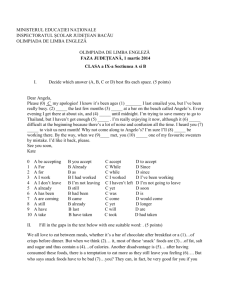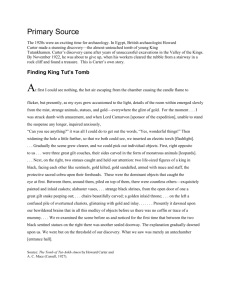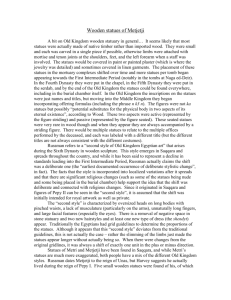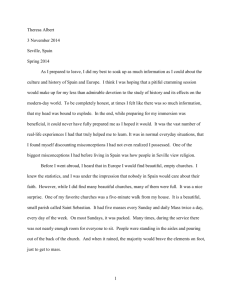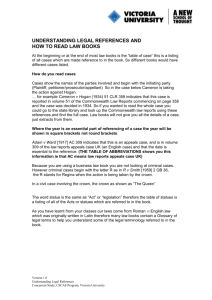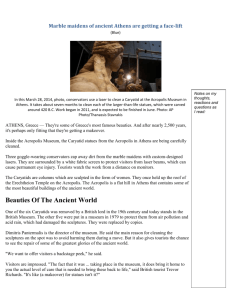DEST-I KIPCAK STONE STATUES
advertisement
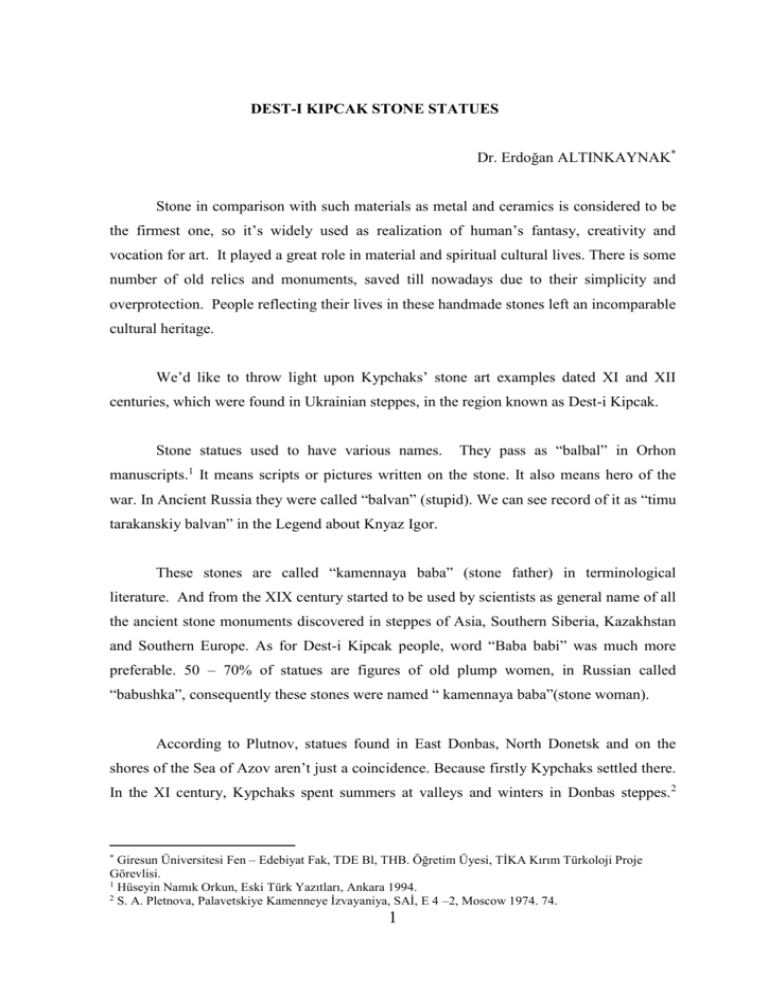
DEST-I KIPCAK STONE STATUES Dr. Erdoğan ALTINKAYNAK* Stone in comparison with such materials as metal and ceramics is considered to be the firmest one, so it’s widely used as realization of human’s fantasy, creativity and vocation for art. It played a great role in material and spiritual cultural lives. There is some number of old relics and monuments, saved till nowadays due to their simplicity and overprotection. People reflecting their lives in these handmade stones left an incomparable cultural heritage. We’d like to throw light upon Kypchaks’ stone art examples dated XI and XII centuries, which were found in Ukrainian steppes, in the region known as Dest-i Kipcak. Stone statues used to have various names. They pass as “balbal” in Orhon manuscripts.1 It means scripts or pictures written on the stone. It also means hero of the war. In Ancient Russia they were called “balvan” (stupid). We can see record of it as “timu tarakanskiy balvan” in the Legend about Knyaz Igor. These stones are called “kamennaya baba” (stone father) in terminological literature. And from the XIX century started to be used by scientists as general name of all the ancient stone monuments discovered in steppes of Asia, Southern Siberia, Kazakhstan and Southern Europe. As for Dest-i Kipcak people, word “Baba babi” was much more preferable. 50 – 70% of statues are figures of old plump women, in Russian called “babushka”, consequently these stones were named “ kamennaya baba”(stone woman). According to Plutnov, statues found in East Donbas, North Donetsk and on the shores of the Sea of Azov aren’t just a coincidence. Because firstly Kypchaks settled there. In the XI century, Kypchaks spent summers at valleys and winters in Donbas steppes. 2 Giresun Üniversitesi Fen – Edebiyat Fak, TDE Bl, THB. Öğretim Üyesi, TİKA Kırım Türkoloji Proje Görevlisi. 1 Hüseyin Namık Orkun, Eski Türk Yazıtları, Ankara 1994. 2 S. A. Pletnova, Palavetskiye Kamenneye İzvayaniya, SAİ, E 4 –2, Moscow 1974. 74. * 1 They are also known to settle in Padansovya.3 They had also brought tradition of making statues from their native land. In Asia vicinities before X and XI centuries such statues were found almost everywhere. In XI – XII centuries Kypchaks inhabited large territory from Europe steppes up to Dnepr river. There is a wide of works on Dest-i Kipcak or “kamenniye babi” statues. The main problem is to determine the certain belonging of these stones to one of the following tribes. There is a large number of theories concerning statues belonging to various tribes inhabited East Europe and Asia steppes, such as Scythians, Sarmat, Hun, Got, Ugor, Pechenek, Bulgar, Slav, Moğol, Kıpcak peoples. Though there is a hypothesis of their belonging to the Bronze Age tribes.4 In 1885 this stone cutting art was officially recognized as traditional art of ancient Turkic tribes. It’s evident and nowadays. Scientists specified them according to outlook, type, form, shape, garment, and icon and composition peculiarities. Working on this topic demands profound knowledge of archeology, history, and plastic arts because of written papers lackness. Being not historians of art, we are aimed at bringing the light to some of Turkic works discovered in Ukrainian steppes. All these statues were investigated thousands of times, though there was only one attempt to give a certain quantity of these stone statues. S. A. Pletnova worked at cartographical system.5 Ministry of Eternal Affairs of Russia made first calculations on 23 of April 1843; Pisarev published the results in 1851.6 645 of them were found in Ukrainian lands. But this number wasn’t a right one. In 1903 and 1905 second calculation provided by Moscow Archeology Organization took place. P.S. Uvarova registered 1113 statues.7 By 1920 this number had grown up to 1300. In 1974 only 644 statues were registered.8 Nowadays we S. A. Pletnova, Polovtsı, Moscow 1990, 34, 35. G. A. Feodorov – Davidov, Kochebniki Vastochnoy Evropi Pod Vlastu Zalatoordinskih Hanov, Moscow 1966, 166. 5 S. A. Pletnova, Palavetskiye Kamennıye İz Vayanniye, SAİ, VIP. E. 4, 2, Moscow 1974. 6 A. N. Pisarov, O Nestonahojdeniyi Kamennıh Bab Rassiyi, ZRAO, T. III., Moscow 1851, 205-220. 7 P. S. Uvarova, K Vaprosu O Kamenneh Babah, TR. XIII, AS. T II. Moscow 1908, 92-96. 8 K. İ. Krasilnikov, Derevneye Kamnereznoye İzkustvo Luganshini, Lugans 1999, 53. 3 4 2 can see only 730 of 1650 registered statues. Unfortunately, the final number of these stone statues is still unknown.9 S. A. Pletnova considers that there were much more statues in the ancient times. In XIX century, there were 428 in Yekaterinoslavye region, more than 200 in Tavrida, 644 in Russian and Ukrainian steppes.10 In 1905, V. A. Harlamov discovered 433 statues in Voyskodonetsky vicinities.11 D. I. Bagalayev found 140 stones in Harkov region.12 In 1879 a huge number of statues were told to be found in Levakovski Bahmut region,13 though the majority of stones was discovered in Slavanoserbsk region.14 330 statues told by Plutneva now are exhibited in National Museums of the Southern Ukraine. They can be also found in parks, museums, but not in their native step- lands15. The biggest collections are represented in Dnieporptrovsk (70 stones), Odessa (35), Mariupol(34), Donetsk (27), Karatish (21), Kharkov (26), Berdyansk (14) and we can see some examples of Kypchaks works abroad in Moscow (43), GIM (33), Krasnodar (53), Novocherkask (18), Taganrog (18). There is 64 stones in Lugansk Pedagogical Institute; 4 stones in Museum. A great number of stones are situated to the South of Lugansk, especially Donetsk hills in Sevrdlosk, Krasnodon, Antratsıtov, Lutiginsk, Perivalski ve Popasnyanski regions (Stanichnoy- Lugansk- Belovotsk- Slavyanoserbskiy-Starybelskiy- Novoaydarskiy- Kremenskoy). Lugansk with its 114 stones according to amount category is second after Dniyepropetrovsk, but first one in statues variety category. There are 17 stones in A. İ. Piskarov, Amestanahojdeniy Kamnennıh Bab Rassiyi, ZRAO, T. III. Moscow 1951, 205. V. A. Harlamov, Okemnneh Babah Danskoy Oblasti, Tr, XIII. Asv, Yekaterinoslavye 1905, T. 2, Moscow 1908., 227. 11 D. İ. Bagaley, Abyesnitelniy Tekst k Arheologicheskoy Karte Harkovskoy Guberniye, Tr., XII. AS, Harkove 1902, T.1, Moskova 1905, ; A. L. Kirilov, Svedeniya A Kamenneh Babah Nahodashıhsa Voblosti Voyska Donskogo, Arhiv GİM, 47/ 434 – 436.- ; O Starine Donskoy Oblasti, TR. VI., AS., T. IV, Odessa 1889. 12 I. S. Levakovski, Ob İskopayemıh Mednıh İz Deliyah, Naydennıh Bahmutskom i Slavyanoserpskom Uyezdah., İOLEAE, T. 35, Moscow 1879, 131. 13 D. İ. Yavornitskiy, Kamenney Babe, İstaricheskih Vestnik, SPb, 1890 T. XI. 14 V. Hlebnikov, Kamennaya Babah, Leningrad 1930, T. IV. 15 V. Hlebnikov, Kamennaya Babah, Leningrad 1930, T. IV. 9 10 3 Sverdlovsk city museum, 3 in Pervomaysk, 4 in Simolanivo village, 2 couples in Lisichansk and Antrosit museums. Statues in Starobel and Robenki villages were ruined.. Nowadays we can see only 730 of 1650 registered statues. 920 of them disappeared in XX century. Scientists suppose that there used to be 40 000 stones excluding wooden balbals. Pletnova stresses that thousands of statues were vandalized in XIII century.16 We possess information only about statues created on the tops of barrows either on some higher places. As example, we can show barrow and the statue found in Lugansk region. The barrow is situated on the right bank of Severskiy Donetsk River to the West of the village. This barrow includes 9 hills. There is a statue on each of the hills, and there were also found 3 thumbs near these wall-shaped stones. Such Ukrainian historians and archeologists as A. V. Tereshenko, D. İ. Yavornitskiy, D. İ. Bagaley, Y. G. Dashkevich, A. İ. Marchenko, L. S. Geraskova, M. L. Shvetsov are well-known Turkic stones art investigators. They facilitated finding ethnic elements, peculiarities of Kypchaks stone- cutting art tradition. A book “ Kipcak statues” by V. I. Vesilovsky is among the most important works17. According to him, statues found in the Eastern Europe in X-XIV are sure to belong to Kypchaks; he found some evidence in Nizami and Rubruk’s works. There is also number of discoveries concerning classifications and origin of these stone statues. G. A. Feododrov-Davidov, L. A. Yevtihova, S. A. Pletnova continued investigations of V.I.Vesilovsky, they found out that garment elements, war ordnance, pots and pans, clothes on these statues are closely connected with each other. Besides clothes, elements the scientists used written sources to fulfill knowledge about stone statues of The Southern Siberia, Kazakhstan and The Central Asia. S. . A. Pletnova, Palavetskiye Kamennıye İz vayanniye, Moscow 1974, 8. . N. İ. Vesilovski, Sovremennoye Sastayaniye Vaprosa o ‘kamennıh Babah’ ili ‘Balbalah’, ZOOİD, XXXII, Odessa 1915. 16 17 4 We can see information about The Siberia Turks from Orhon manuscripts. But unfortunately, they don’t give us detailed information. In historical context, works by Nizami and Papa Vilhelm D. Rubruk lived in XIII century are richer in contence. In his poems Nizami depicts some stone statues and tradition of soldiers laying gifts to these sacred stones.18 An other source of information are notes of one ambassador passing Kypchaks steppes in 1253: Kipcak warriors are making small hills near the sepulcres and erect statues turned to the East in the shape of human figures keeping bowl in their hands.19 These are words of two contemporary writers.20 Many centuries passed, there are no descriptions of traditions, rituals, holidays of Kypchaks, but stone statues still exist. In 1594 Germany Ambassador E. Lassotta describing Zaporojye people writes: We can see more than 20 stones on barrows and thumbs in Tatars lands. In 1627, “A Big Routes Book” was published in Russia. Stone statues from 3 different parts were shown as so-called destination showing signs.21 These stones pass in letters of scientists, geographies, and soldiers. In 1738 The Crimean War times German doctor Y. Lerhe writes about women shaped stones on Northern shores of the Sea of Azov. In 1763 academician, G. F. Miller found stone statues while digging some cemeteries.22 Group of scientists namely P. S. Pallas, İ. İ. Lepehin, V. F. Zuyev and other. Give us detailed description of these stones found in The South- European part of Russia. In 1851 was published one of the most important maps. The author is employee of The Ministry of Eternal Affairs of Russia A.I. Piskarev. Piskarev gave profound description of statues discovered in Russia. In 1871 A. S. Uvarov taking as example 1000 statues classified them into 3 groups. They are: 1. Standing, 2. Sitting, 3. Squatting figures. They were distinguished according to evolution process also: 1. Crude workmanship works, 2. Relief works. We can see that all these works belonged to one people group but in different times.23 18 We can find out some information in book Türklerin Dini Tarihi by Ünver Günay and Harun Güngör, İstanbul 2003 Also.: S. A. Pletnova, Palavetskiye Kamenneye İzvayaniya,, Moscow 1974. Kypchaks will come here / They will bow to these statues / Can come by foot or riding a horse / Worship these statues / Stop their horses / takes an arrow and shoots it into the grass / all the shepherds passing through this statue know/ that one day they are to sacrifice one sheep of his herd 19 V. D. Rubruk, Puteshestviye Vastochniye Stranı Plano Karpini i Rubruka, Moscow 1957. 20 S. A. Pletnova, Palavetskiye Kamenneye İzvayaniya, Moscow 1974. 21 K. M. Serbinoy, Kniga Bolshomu Chercheju, Moscow-Leningrad 1950, 64-65, 68, 86. 22 G. F. Miller, İzyasneniye o Nekotorıh Drevnosah Magilah Naydennıh, SPb, Aralık, 1764. 23 S. A. Uvarof, Svedeniya O Kamennıh Babah, Tr. I – AS. T. I, Moscow 1871. 5 In the beginning of XX century scientists decided to check number of statues given by A. S. Uvarov, and in 1908 found out 1133 stone statues in the Southern Russia.24 Now women shaped statues and balbals are topics of prime importance. In 1915, Vesilovsky printed research work about statues situated in the South European steppes.25 Vesilovsky comparing clothes elements of these statues to modern people clothes of Turkic men and women confirmed V. Rubruk’s opinion. An other problem to solve was the certain name of ethnic group, which these statues belonged to. But still it became archeological task, so the search of it was permanently stopped. In 1952 L. A. Yevtihova publishing an article “ Stone statues of Southern Siberia and Mongolia» brought the light to this problem.26 There were given some archeological facts concerning this topic the first time after works of Vesilovsky. Furniture, garment elements, war ordnance, pots and pans, decorations were analyzed in details. In 1960-80, statues dated XI-XIII centuries in Eastern Europe were compared to Sibiria, Semirich, Mongolia, Kazak and Altay statues of VI-VIII centuries. We can see evidences of it in contemporary literary works. Statues found in Southern and Eastern Europe have much in common.27 According to scientists opinion statues are 1. realistic, 2. 3- dimensioned, 3. detailed, 4. posed. Comparing statues from Western Europe to statues from Eastern Europe the first group is considered to be more developed. So we can see the row starting from VI- VII centuries Altay and Mongolia, then Kazakhstan and Semirechye and finally XII-XIII centuries the Eastern Europe. It’s a row of the Middleage Turkic nomadic life. In 1966 G. A Feodorvo- Davidov wrote a book about Turkic migrations during government of Altin Orda Khans and gave a vivid description of stone statues, their shapes, art tradition and regions where they had been found. 28 After this book had been published statues belonging to Kypchaks became evident S. A. Uvarof, Svedeniya O Kamennıh Babah, Tr. I – AS. T. II, Moscow 1871, 92-96. N. İ. Vesilovski, Sovremennoye Sastayaniye Vaprosa o ‘kamennıh Babah’ ili ‘Balbalah’, ZOOİD. T. XXXII, Odessa 1915. 26 L. A. Yevtihova, Kamenniye İzvayanniye Yujnoy Sibiri i Mongolii, MİA vıp 24, Moscow 1952. 27 A. D. Grach, Drevniye Türkskiye İzvayaniye Tuvi, Moscow 1961, 67. 28 G.A. Feodorov-Davidov, Kochevniki Vastochniy Yevropi Pod Vlastyu Zolotoordınskih Hanov, Moscow 1966. 24 25 6 Pletnova’s book under title Kypchaks Stone Statues written in 1974 is considered to be profound research work.29 About 1323 statues were used as material for this work, 45 statues from Lugansk region were described and was given an information about shapes of 90 statues. It’s one of vital publications in this sphere. We can see female attributes in these statues, such as a necked big breast, hips, belly, female clothes, flowing hair. Even female genitals are shown sometimes. But we can’t see such gender attributes in male statues. As usual these statues have beard and helmet, they can be also dressed in military uniform. There are some statues where gender is not evident. Such vagueness is seen in statues from Kars/ Arpacay region cemetry, each statue is having some certain symbol which shows its belonging to female or male gender.30 But there were also found bothgendered statues. Male statues dating XIII century had female attributes such as big breast. In 1851 was published one of the most important maps. The author is employee of The Ministry of Eternal Affairs of Russia A.I. Piskarev. Piskarev gave profound description of Dest-I Kipcak statues discovered in Russia. In 1974, Kipcak balbals catalogue was published as journal. There was information about statues saved till 1970. 45 of 1323 statues published in this catalogue were found in Lugansk region.31 Despite of A. S. Uvarov and V. I. Vesilovsky attempts to classify these stones, this problem still exists. But still the evolution process is determined.32 Uvarov divided statues to three groups: sitting, standing and smooth. He also divided hem to male and female statues. The smooth statues belonged to earlier period, sitting figures and sphere-shaped are dated to IV-V centuries and later period. S. A. Pletnova, Palavetskiye Kamenneye İzvayaniya, SAİ, E 4 –2, Moscow 1974. Altınkaynak, Arpachay Mezarları ve Mezar SHekilleri, Anayurttan Atayurda Türk Dünyası, 18, Ankara 1999. 31 S. A. Pletnova, Palavetskiye Kamenneye İzvayaniya, SAİ, E 4 –2, Moscow 1974., 95-97. 32 S. A. Uvarov, Svedeniya O Kamenneh Babeh, Tr. I., AS. T. I, Moscow 1871. 29 30 7 Soon, after 100 years passed, G.A. Feodorov-Davidov classified statues according to their poses, stressing that sitting and standing poses are samples of Kypchaks’ later period.33 Pulitnova pays great attention to gender attributes of the statues. People taken as model for these statues are social, political, religious people according to Pulitnova.34 Pletnova divided all the statues to male and female. The second category is poses of these statues, sitting, standing and smooth without any special attributes. The number of statues is almost equal in all these groups. They are also divided to 3 groups according to their outlook.35 But Krasilnikov’s research work shows that it’s not the last number, there are even more shapes.36 We can see also a titanic research work about stone cutting art tradition of nomadic tribes inhabiting Eurasia in late period written by Geraskova.37 Uvarov worked only over sitting statues. A type of male with female breast is the result of religious influence. In Turkic legends and epic stories, bogatyr with female breast symbolizes a great power and vita. In Turkic legends bogatyr after sucking his mother becomes stronger, and is ready to fight. For instance, Oguz sucks his mother only once then he demands meat and wine.38 Probably it is connected with protective spirits.39 According to Pletnova stone cutting art started to regress when Kypcaks ruling in the East -European steppes was coming to an end. It’s the last phase of evolution process of this art tradition, but there is a probability of statues being ruined during Mongols G.A. Feodorov-Davidov, Kochevniki Vastochniy Yevropi Pod Vlastyu Zolotoordınskih Hanov, Moscow 1966, 167-186. 34 S. A. Pletnova, Palavetskiye Kamenneye İzvayaniya, SAİ, E 4 –2, Moscow 1974., 60. 35 S. A. Pletnova, Palavetskiye Kamenneye İzvayaniya, SAİ, E 4 –2, Moscow 1974., 55. 36 K. İ. Krasilnikov, Derevneye Kamnereznoye İzkustvo Luganshini, Lugansk 1999, 22. Types and pecularities of the statues I. Statues with flat form II.Statues in form of column, early period, to the waist. III. Sitting figures with round shapes. IV. Squatting figures with round shapes V. Sitting figures with round shapes VI. Standing figures with round shapes dated later period VII. Statues of other types VIII. Half statues. 33 37 L. S. Geraskova, Skulptura Serednovichnih Kochovikiv Stepive Shidnoi Yevropi, Kiev 1991. Zeki Velidi Togan, Oğuz Kagan Destanı. 39 Bahaeddin Ögel, Türk Mitolojisi, İstanbul 1994. 38 8 capture. We can connect regress of Kypcaks art with hostilities in XIII century. So, they started to fight against Mongols Horde. Pletnova considers all the statues erected in that period to commemorate soldiers. In XI-XII, faces of Kypchaks statues started to become rounded. From the beginning to the middle of XIII century, we can see modern tendencies in Kypcaks art, faces become rounded, composition is more complete, but it develops before the middle of XIII century. A XII and XIII century is the height of mastery for Kypchaks. During this period, Kypchaks owned large territories in the Eastern Europe (380000 square km.) It was a period of Derebeyliks government.40 Using topography of Padansovye, winter sacred places, chapel, stone fireplaces, workshops of Kypcaks inhabiting Nijnedonetsk and Donetsk were found.41 In the cities Sverdlovsk, Antratstosk, Krasnadonsk, Perevalskoye, Popasnanskoye situated in the North mountains range. Female attributes of the statues are clothes, hair, and decorations. There are some differences between women and man shaped statues. Even if clothes, shalvars, shoes look alike, only male could have a military uniform on. Women shaped statues have decorative headdresses. Statues possess such male attributes as caftan, trousers- shalvars, shirt, sash, short boots, hat, and helmets for soldiers, chain mail, saber, arrow, and dagger. The even had daily attributes also: knife, lighter, hairbrush, pin, and instruments and sometimes mirror. Some of these statues have long 2-3 plaits under the hat. Women shaped statues have different headdresses, bright decorations, and plaits. There are 6 types of female headdress.42 There are some common points with male clothes. They have caftan with embroidery, trousers-shalvars, short soft boots. Decorations are shown perfectly. There are 6 kinds of necklace. These statues may have amulets, bracelets S. A. Pletnova, Palavetskiye Kamenneye İzvayaniya, SAİ, E 4 –2, Moscow 1974, 23. S. A. Pletnova, Palavetskiye Kamenneye İzvayaniya, SAİ, E 4 –2, Moscow 1974., 19, 23. 42 S. A. Pletnova, Palavetskiye Kamenneye İzvayaniya, SAİ, E 4 –2, Moscow 1974., 51-52. 40 41 9 and etc. also daily used knife, hairbrush, pin, instruments and mirror. As for clothes all the Turkic tribes have much in common The most widespread element is kase (cup). It’s kept on waist level and has a symbolic meaning. There 5 kinds of kase: in the form of cylinder, round, cylinder like, cone, glass shaped. These cups outlook peculiarities are not as important as aims of its usage. Some scientists consider this cup with water to be symbol of eternal life. Some of scientists suppose them to have sacred ashes of their dead relatives or their Saints. An other group considers it to be attribute used at rituals. Ethnographer and archeologist Bernstam says that Cup is a great symbol of respect to the relatives and shows the strength of family ties.43 Some of the statues had cup in one hand and bird in the other. This bird is a symbol of dead man’s soul. L.R. Kizilatsov gives us a theory concerning these attributes. He thinks that religious people used this cup to eat and to drink. According to their ritual the spirit of dead person materialized in this statue should have been together with relatives.44 Relatives talking to the spirit of the dead person were eating and drinking with him. They made a fire in the legs of his statue and make a sacrifice. They believed bad spirits to disappear at that moment and expiate sins. Cylinder kase had seeds planted into the ground. Kypcaks don’t have cup shaped kase. They have some elements of rectangle. Sometimes we can see even kases in a form of jug. The ceramic elements are met rather rare in XII-XIII centuries. All the scientists were interested in two main topics. Who these statues were made for: to commemorate dead soldiers or they are statues of their enemies? The second one is the reason of their erecting statue in one concrete place and their importance and the role in religious rituals?45 Pletneva resists on Kypcaks erecting their statues according to some rules. As usual they used to erect these statues on the top of kurgan. These kurgans are relicts of Scythian A. N. Bernshtamü İstoriko Arheologicheski Ocherk Sentralnogo Tiyan-Shane i Pamiro – Altaya. MİA, VIP, 26, Moscow – Leningrad 1952, 9-10. 44 L. R. Kızlasov, O Naznacheniye Drevniye Turskih Kamennıh İz Vayani, İzobrajayushıh Ludey. ‘SA,’ 1964, No: 2, 36. 45 G. S. CHirikov, Kamenneye Babi v Harkovskoy Guberniyi, Harkov 1901, 8-9. 43 10 cultural heritage or even remains of the Bronze Age culture. Taking into account that statues were mainly built on kurgans there is sure to be connection between them in XIX century also. Kurgans were considered to be left from The Bronze Age and Scythians times. In 1901 during XI. Session of Kharkov Archeological Community was taken a decision to find out the certain number of kurgans where the stone statues had been built. And during 1893-1914, approximately 50 kurgans were discovered. According to the research work results these statues are doubtlessly have nothing in common with sepulchers of nomadic tribes. For instance, in 1905 Trefilyev researched two kurgans. He found some subjects belonging to Turkic tribes dated X and XI centuries and the Bronze Age, but not to Kypchaks. In the beginning of XX century Gorodsov investigated 8 new kurgans. But there were no tracks of Kypchaks culture in 6 of them.46 Vesilovsky told that statues had nothing in common with those sepulchers.47 He protected Rubruk only in following items. In Pletneva’s point of view, after 950 kurgans had been dug all of them had sepulchers but not stone statues. So according to this fact statues were not used as gravestones in Kypchaks culture. Provalskoy didn’t find any stone statues investigating kurgans and cemeteries in steppes. But there are some stone statues found on common Kypchaks cemeteries erected in honor of noble men.48 Provalsky discovered some statues and stonewalls looking like chapel.49 The splendid number of statues was discovered in Provalya district of Lugansk region. Every fifth of all the statues registered in the catalogue had been found there. May be in vicinity of the King rocks stone fireplaces or workshops were founded primarily. Such workshops are supposed to be permanent but built inside the chapels. Everybody shouldn’t obviously erect the balbal in honor of the dead person. It all depended on economic conditions. It became evident that women-shaped stone statues commemorated their ancestors. Garment elements of the statues found on Kypchaks S. A. Pletnova, Palavetskiye Kamenneye İzvayaniya, SAİ, E 4 –2, Moscow 1974., 72.; L. P. Krilova, Kamenneya Babi Katalog, Dnepropetrovsk 1976, 11. 47 N. İ. Vesilovski, Sovremennoye, Sostoyanniye Vaprosa o ‘Kamenneh Babah ili Balbalah’ ZOOİD. C. XXXII, Odessa 1915. 48 M. İ. Gladkih, İ. A. Pislariy vs, Rabotı Severiskodonetskoy Ekspiditsiy, AO, 1973, Moscow 1974, 267 – 268 ; İ. A. Pislariy, A. P. Filatov, Tayni Stepnıh Kurganov, Donetsk 1972) 49 L. S. Gerayskova – İ. A. Pislari, Raboti v Provalskoy Stepi, AO, 1978, Moscow, 1979. 46 11 cemeteries looked like clothes of well-to-do people of that times.50 That fact that Kypchaks erected stone statues of their enemies is fixed in the South Siberian manuscripts. For instance one Mongolian tribe known as Tuku dug stones on the graves. According to the Tuvinian epic stories during the wedding ceremony people measured heroism of the bridegroom by number of statues of all the enemies he had killed. Here is an answer of Rubruk to question concerning reasons of digging those statues: “Kumans after making a hill where a dead person is buried, also erect a statue in his honor.” It is stressed that they didn’t erect stone statues of the dead person but statues in his honor. Another group of scientists have a little bit different point of view. It’s not an opposite of these two theories but their evolution. According to the following theories Turkic tribes had abundant morning ceremonies that times. We can divide it into two periods of their nomadic life. During the first so-called “Asia” period vertical rock-shaped human statues and plates symbolized their enemies. During the second one when Turkic tribes moved to East Prichernomorya steppes and had some religious metamorphoses the balbals became symbols of the dead people themselves. In the XX century with assistance of Archeology Committee archeologists arranged some research works of the statues erected on the kurgans. As the majority of the statues dated The Bronze Age only few of them belonged to Pechenegs, Kypchaks and other Turkic tribes. The results of that research work showed that there were no grave- stone statues belonging to Kypchaks. That times Kypchaks preferred tops of the hills or kurgans to erect their stone statues. There were also statues erected on the roads and crowded places. There were singular statues and group statues of 2 up to 20 figures discovered over there. We can see some information about group statues consisting of male and female in scientific work called “Kniga Bolshogo Chercheja” (A Book of Big Drawings). There is sure to be question whether women and men had not been buried together. Unfortunately we haven’t found answer yet. Garatsov arranged some scientific expeditions to the Eastern Europe regions and classified these statues according to various shapes. Feodorov Davidov called a group of stones the Chapel. He came to such conclusion after he had 50 A. Pletnova, Palavetskiye Kamenneye İzvayaniya, SAİ, E 4 –2, Moscow 1974., 32. 12 discovered remains of sacrifices near the stone statues.51 People mainly sacrificed bull, sheep, and dog. Kypchaks the same as all the Turkic tribes had some totem animals. For example names of khans Kobek and Konchak mean male and female dog. Dogs’ skeletons are supposed to be found on their cemeteries. Some of such chapels were found in the center of mountains row in Donetsk, Rostov and Lugansk regions in the village of Novoselovka, region of Telmanovski, Starı Beshevski region in the village of Kamenka, Sverdlovski region in the village of Astahlı, Lutuginski region in the village of Poliyevka, Sverdlovski region in the village of Provalye, Rastovskiy region in the village of Livenitsovka.52 These chapels were brought to Europe by nomadic tribes from Siberia and Middle Asia. In VI and VIII centuries stonewalls without roof were built around the stone statue.53 The ceremony of sacrifice took place overthere. The same ritual is obsrved in culture of Kypchaks inhabiting Europe in XI-XIII centuries. The stone statues were erected in the chapels far from the cemetries. Nizami shows us that ritual of sacrifice was held in honor of these statues, people asked them for the help, for strongth and power in struggle against their enemies.54 All these stone statues are different in size. The most plain of them were found in sverdlovsk region village of Cheremshino and Zimovki. Faces of these statues look to the East. And there no stonewalls on kurgans. The second type of statues is oval and round pyramid built right in the middle of the chapel. The ritual of sacrifice was held there (Sverdlovsky region village of Astahovo). The third type is rectangular chapel surrounded by stonewalls overlooking 4 parts of the world. There is a statue in the middle, and some area for sacrifice around it. SG.A. Feodorov-Davidov, Kochevniki Vastochniy Yevropi Pod Vlastyu Zolotoordınskih Hanov, Moscow 1966, 191 - 192. 52 Y. K. Guguyev, S. V. Gurkin, Polovetskoye Svetilishi Serediniy XI. Nachala XIII. Na Pravuberejye Dona / Sbornik ‘Drevnosti Dona’, VIP I. , Azov 1992, 114 – 141. 53 A. D. Grach, Drevne Türkskiye İz Vayaniya Tuvi, Moscow 1961, 55. ; Y. A. SHer, Kamenneye İzvayaniya Semerechya, Moscow Leningrad 1966, 20 ; L. R. Kızlavsov, İstoriya Tuvi Sredneya Veka, Moscow 1969, 29. 54 Karasilikov, a.g.e., 37. 51 13 Sometimes walls looking at East were double. There were statues in the middle and along the edges. We can see also fireplaces and places for sacrifice nearby.55The variety of Kypchaks’ chapels is determined by social level of the society. They are family, dynasty, military chapels and etc. The most beautiful chapel of Lugansk is situated in Astahly village.56 Kurgan dated The Bronze Age was found over there. Kypchaks built the chapel in the form of square with 16 meters diameter. There was a statue right in the center of the square. The third statue in this chapel was cut to small pieces. Another two sitting statues were figures of enemies. And they had helmets on. These statues were brought to school in Sverdlovsky region village of Novoborovitsy. Almost the same chapel was discovered in Poliyevka village. Remains of it are exhibited in Lugansk Pedagogical University. As far as we can judge Kypchaks were using these statues during their religious rituals and these chapels used to be their first sites. They were primarily used to worship their ancestors, show their respect to totems, to pray Mother priestess (Umay Ana). Sometimes statues had the same features as the dead person, for instance man-shaped statue found in the village of Prichepilovka. Prevalence of family ideology is reflected in woman-shaped statues. This group of statues is dated to The Stone Age times of matriarchy. But Kypchaks’ statues appeared in the period of patriarchy. It’s curious to know the main reason of erecting woman-shaped statues and their significance. Probably these statues could be symbols of family ties or even represent maternal ancestors. There is also an idea that they can be statues of respectable women or mothers of warriors. In 1971 a statue of women keeping a child in her arms was found in Perebalsky region village of Chernuhino.57 Despite of looking like other statues this one has some extraordinary features. The statue has some original headdress. All the details of the statue 55 Y. K. Guguyev, S. V. Gurkin, Polovetskoye Svetilishi Serediniy XI. Nachala XIII. Na Pravuberejye Dona / Sbornik ‘Drevnosti Dona’, VIP I. , Azov 1992. 56 M. L. SHvetsov, Polovetskiye Svetilisha, ‘SA’, 1979, No 1. 206-208. 57 S. A. Pletnova, Jenskaya Polovetskaya Statuya s Rebenkom, ‘SA’ 1979, no 1. ; L. S. Geraskova, Polovetskova Statuya İz S. Chernuhino ‘SA’ 1974, no 3. 14 are made with great mastery. One more interesting thing is figure of baby laying in the stomach. Despite of the period of patriarchy this child isn’t a boy but a girl. This statue has a great significance from cultural, religious and art points. A woman has a dress stressing her female shapes. We can see her breast-feeding a little child. It’s sure to be connected with giving life to generations to come. It can be also statue of woman died with a child or during pregnancy period. We can see that Kypchaks have matriarchy social structure. Statues generally had sitting or squatting poses. According to G.A.FeodorovDavidov poses depend on chronological system.58 This theory shows that poses differed in connection with social level. Standing poses of male-shaped statues belong to captains or officers, squatting or sitting poses- to common people. They don’t have any weapons but kese (cup), knife and hats instead of helmets. It is sure to be identification of social groups in Kypchaks’ society. As concerns woman-shaped statues, the situation is almost the same. Standing statues show belonging to well-to-do social groups. There are necklace on breast, neck and hair, earrings, precious stones and rings. They have also mirror, hairbrush, kese and etc. Statues with standing poses are more decorated than half-bounded or sitting one. Masters contributed more skills towards them. So did Kypchaks’ lowest level of population build balbals to their ancestors? It’s quite possible. They were made of wood and stone. And have very plain forms. Rubruk gives some information concerning idols found in houses.59 Kypchaks inhabited Ukrainian steppes were rich and noble. Balbals erected in groups were dug on roads in order the entire passing people to revere and make a sacrifice. Then these places were used as chapels. With the time passing worshiping the ancestors turned to honoring noble men and feudalists. But in the middle of XIII century Mongol invaders started to exterminate wellto-do Kypchaks’ families. After leaders and chiefs had been killed statues were ruined. Most of them were destructed and dug in the chapels. Though years and centuries passed some traditions of great respect to ancestors still remain in Russian and Ukrainian cultures. 58 G.A. Feodorov-Davidov, Kochevniki Vastochniy Yevropi Pod Vlastyu Zolotoordınskih Hanov, Moscow 1966, 184. 59 V. D. Rubruk, Puteshestviye Vastochniye Stranı Plano Karpini i Rubruka, Moscow 1957, 94. 15 They could even idolize Kypchaks’ noble men. Every spring countrymen of Sakolniki village in Slavanoserpsky region decorate these statues with flowers. They believe in idols’ power to bring happiness and prosperity. People from village of Kamenka Vutiginsky region have a strong belief in their “Katyas” protective power. We can classify statues according to materials. Mostly statues were made of two types of materials: volcanic and sedimentary rocks. Some of the scientists supposed these materials had been brought from far regions, Mongolia for instance, but they appeared to be wrong. According to geological research work, such materials were found in Lugansk and Donetsk regions.60 In XIII century Mongolian invaders aroused hostile attitude to these statues. During research works, almost all of them were found buried in kurgans by Kypchaks or probably destroyed by Mongols. Each of these points of view is right. But Kypchaks themselves mostly ruined statues.61 If the statue was done of sand or soil they cut it into small pieces,62 if it was done of stone or other firm materials they cut its had and then dug. We can see that invaders absolutely destroyed Kypchaks’ culture. Another reason can also be spreading of Islam, brought by Mongols to Kypchaks’ lands. XIII century is fatal for Kypchaks’ culture. In XV and XVII centuries statues were used as road signs in steppes. In XVIII and XIX centuries, they were used as building materials. After Turkic and Tatar lands in Preazovye and Prechernomorye steppes were occupied, statues were ruined. The most beautiful of them decorated houses of rich and prosperous men in South Russia and Ukraine. About 15 of those statues were discovered near the lake in vicinity of Elin Bor and Krivorojye Lugans region. Old legends say that they are still in clay of the lake. One of these statues was brought to Lugansk museum. According to sources of 1790s some of statues were damaged while transportation from their original places to residences.63 V. 60 Krasilnikov, a.g.e., 50-53. G. S. Chirikov, Kamennıye Babı Harkovskogo Gubernii, Harkov 1901, 10. 62 M. L. Shvetsov, Polovetskiye Svetilisha, ‘SA’ 1979, No.1, 206-207. 63 M. Gatry, Puteshestviye v Gadah 1795 – 1796 CHerez Tavriu ili Krım Kdrevnemo Bosporskomu Tsarstvo, London 1802, 405-408. 61 16 Pasek requires information about 30 statues broken in Shdlovskys’ detached house in Harkov region.64 In XVII and XVIII centuries Ukrainian and Russian Cossacks ruined thousands of kurgans and used staues as gunpowder and building materials. There are also tracks of treasure-seekers. Orthodox churches supported destroyment of idels as well. People started to believe that these statues were figures of frozen men who disobeyed God’s word. People who believed in these idols were punished by Church.65 In the second half of XIX century hostile atitude to statues changed. And they started to be used as building materials, animals’ grass cups, water cups, fence and etc. In valleyes balbals served as resting place for shepherds and scratching place for animals. İt used to be a target-board for thieves had been kept. You can see that they were largely used in various spheres of life. We can]t give you even aproximate damages volume. Lots of stones were used for building roads. In Katherine the Great times thousand kilometres of these roads were built of statues.66 Writers of that times depisted these statues as ghosts frightening peaceful people. That’s why they were ruined in all parts.67 In XIX century scientists and historians V. V. Passek, A. V. Treshenko, G. S. Chirikov, D. Y. Samaylov, D. İ. Yavornitskiy, N. E. Brandenburg, A. İ .Piskarov, A. S. Uvarov, N. İ. Vesilovski, V. A. Garatsov insisted on protection of these historical monuments. In Tsar times this idea wasn’t welcomed. On December 1843, The Empire Academy recived an application concerning measures to protect the statues. But still people continued to destroy them.68 Only in 1843, after Piskarev registered all the statues, vandalism was stopped.69 Even under protection of Russian and Ukrainian museums statues continued to disappear. While erecting monument to Knyaz Igor in 1995 stones of balbals were used. Project expert I.M. Chumak being sculptor facilitated destroying of historical monument. 64 G. S. Cherekov, Kamenneye Babe Harkovskoy Guberniyi, Harkov 1901, 12. D. Kınyajevich , Kamenneye Babe, ZOOİD, T I, 1848, 597.; A. Tereshenko, Ocherki Novorosiskogo Kraya, JMNP, CH, 79, 1853, N0. 8., 44. 66 A. O. Treshenko , O Magilnih Nasıpah i Kamenneh Babah v Ekaterinoslavskoy i Tavricheskoy Guberniyah, UOİDR, 1866, 4. Kitap, 15. 67 İ. Rodojidskiy Nechto o Kurganah, Sın Otechestva; CHast 97, SPB 1824, 114-115. 68 N. İ. Vesilovski, Sovremennoye Sastayaniye Vaprosa o ‘Kamenneh Babah ili Balbalah’, ZOOİD, Odessa 1915, T XXXII, 419-421. 69 A. İ. Piskarov, O Mesto Nahojdeniy Kamennıh Bab v Rossii, ZRAO 65 17 This statue should have been ruined for that reason that it was example of Turkic cultural inheritance. We can’t imagine Eastern and Southern parts of Eastern Europe without Turkic culture. Turkic tribes were moving from Asia to Europe. A lot of European countries were influensed by their culture. İn Volga and Dunay steppes were found about 2000 nomedic graves. They mostly belong to Kypchaks. Garment elements, weapons, pots and pans are examples of Kypchaks’ cultural history. Research works of these statues brought the light to rich cultural inheritance ofKypchaks. We could see thousands of statues standing in all places in XIII century. But being greatly damaged and ruined in XIX and XX centuries, only 1400 of the statues remained till nowadays. We could see even less, if scientists of XIX century didn’t make every attempt to protect them. In 1970, collection of statues was opened in Lugansk Pedagogical University. We can see samples of Kypchaks’ art, culture and civilization. Shapes of statues, variety of garment elements amazed us greatly. Everything, clothes, garment, decorations, shoes, headdresses give us information about Kypchaks’ culture. İt’s no doubt that none of manuscripts could describe it as vividly as it’s done by statues. 18 BIBLIOGRAPHY: A. İ. Piskarov, Amestanahojdeniy Kamnennıh Bab Rossiyi, ZRAO, T. III. Moscow 1951. A. L. Kirilov, Svedeniya A Kamenneh Babah Nahodashıhsa Voblosti Voyska Donskogo, Arhiv GİM, 47; O Starine Donskoy Oblasti, TR. VI., AS., T. IV, Odessa 1889. A. N. Bernshtam İstoriko Arheologicheski Ocherk Sentralnogo Tiyan-SHane i Pamiro – Altaya. MİA, VIP, 26, Moscow – Leningrad 1952. A. N. Pisarov, O Nestonahojdeniyi Kamennıh Bab Rassiyi, ZRAO, T. III., Moscow 1851. A. O. Treshenko , O Magilnih Nasıpah i Kamenneh Babah v Ekaterinoslavskoy i Tavricheskoy Guberniyah, UOİDR, 1866, 4. book A. Tereshenko, Ocherki Novorosiskogo Kraya, JMNP, CH, 79, 1853, N0. 8. A.D. Grach, Drevne Türkskiye İz Vayaniya Tuvi, Moscow 1961. Bahaeddin Ögel, Türk Mitolojisi, İstanbul 1994 D. İ. Bagaley, Abyesnitelniy Tekst k Arheologicheskoy Karte Harkovskoy Guberniye, Tr., XII. AS, Harkove, I, 1902, Moskova 1905. D. İ. Yavornitskiy, Kamenney Babe, İstaricheskih Vestnik, SPb, XI, 1890. D. Kınyajevich , Kamenneye Babe, ZOOİD, I, 1848. Erdoğan Altınkaynak, Arpachay Mezarları ve Mezar Shekilleri, Anayurttan Atayurda Türk Dünyası, 29, 2001. Enver Günay - Harun Güngör, Türklerin Dini Tarihi, İstanbul 2003. G. A. Feodorov – Davidov, Kochebniki Vastochnoy Evropi Pod Vlastu Zalatoordinskih Hanov, Moscow 1966. G. F. Miller, İzyasneniye o Nekotorıh Drevnosah Magilah Naydennıh, SPb, 1764. G. S. CHirikov, Kamennıye Babı Harkovskogo Gubernii, Harkov 1901. H Namık Orkun, Eski Türk Yazıtları, Ankara 1994. İ. A. Pislariy- A. P. Filatov, Tayni Stepnıh Kurganov, Donetsk 1972. İ. Rodojidskiy Nechto o Kurganah, Sın Otechestva; CHast 97, SPB 1824. İ. S. Levakovski, Obiskopayemıh Mednıh İzdeliyah, Naydennıh Bahmutskom i Slavyanoserpskom Uyezdah., İOLEAE, XXXV, Moscow 1879. K. İ. Krasilnikov, Derevneye Kamnereznoye İzkustvo Luganshini, Lugans 1999. K. M. Serbinoy, Kniga Bolshomu CHercheju, Moscow-Leningrad 1950. L. A. Yevtihova, Kamenniye İzvayanniye Yujnoy Sibiri i Mongolii, MİA Vıp 24, Moscow 1952. L. P. Krilova, Kamenneya Babi Katalog, Dnepropetrovsk 1976. L. R. Kızlasov, O Naznacheniye Drevniye Türskih Kamennıh İz Vayani, İzobrajayushıh Ludey.‘SA,’1964,No: 2 _____________, İstoriya Tuvi Sredneya Veka, Moscow 1969. 19 L. S. Geraskova, Polovetskova Statuya İz S. CHernuhino ‘SA’ 1974, no 3. _____________, Skulptura Serednovichnih Kochovikiv Stepive Shidnoi Yevropi, Kiev 1991. _____________ – İ. A. Pislari, Raboti v Provalskoy Stepi, AO, 1978, Moscow, 1979. M. Gatry, Puteshestviye v Gadah 1795 – 1796 CHerez Tavriu ili Krım Kdrevnemo Bosporskomu Tsarstvo, London 1802. M. İ. Gladkih, İ. A. Pislariy vs, Rabotı Severiskodonetskoy Ekspiditsiy, AO, 1973, Moscow 1974. M. L. Shvetsov, Polovetskiye Svetilisha, ‘SA’ 1979, No.1. N. İ. Vesilovski, Sovremennoye Sastayaniye Vaprosa o ‘Kamenneh Babah ili Balbalah’, ZOOİD, T XXXII, Odessa 1915. P. S. Uvarova, K Voprosu O Kamenneh Babah, TR. XIII, AS. T II. Moscow 1908. S. A. Pletnova, Jenskaya Polovetskaya Statuya s Rebenkom, ‘SA’ 1979, no 1. ____________, Palavetskiye Kamenneye İzvayaniya,, Moscow 1974. ____________, Palavetskiye Kamennıye İz vayanniye, Moscow 1974. S. A. Uvarof, Svedeniya O Kamennıh Babah, Tr. I – AS. T. I, II Moscow 1871. V. A. Harlamov, Okemnneh Babah Danskoy Oblasti, Tr, XIII. Asv, II, Yekaterinoslavye 1905, Moscow 1908. V. D. Rubruk, Puteshestviye Vastochniye Stranı Plano Karpini i Rubruka, Moscow 1957. V. Hlebnikov, Kamennaya Babah, IV, Leningrad 1930. Y. A. SHer, Kamenneye İzvayaniya Semerechya, Moscow Leningrad 1966. Y. K. Guguyev, S. V. Gurkin, Polovetskoye Svetilishi Serediniy XI. Nachala XIII. Na Pravuberejye Dona / Sbornik ‘Drevnosti Dona’, VIP I. , Azov 1992. 20

